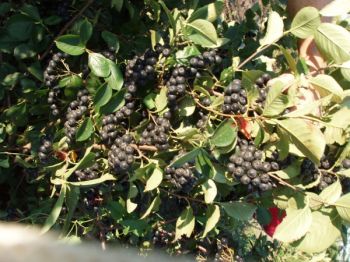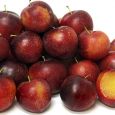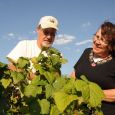The Gift of South Dakota
Subscriptions to South Dakota Magazine make great gifts!
Subscribe today — 1 year (6 issues) is just $29!
Better Living Through Berries
Aug 1, 2013
“Berries make better bodies,” according to Jeff & Jolene Stewart. Since 2008, they’ve been growing the aronia berry, a tart, dark purple superfruit loaded with antioxidants, on their ranch near Wagner.
Their healthy journey began in the bermed flower beds of their home in Idaho, where Jeff was employed with the Department of Agriculture. “Jeff noticed that on the top there were all these bushes that had these dark, deep purple berries,” Jolene said. A tag on one bush identified the fruits. “As we moved to South Dakota and Jeff worked more with specialty crops, we got interested in them. The more we learned about the health benefits, the more we decided that this was something we wanted to raise,” Jolene said.
Aronia berries are also called chokeberries — a name that can generate some confusion. Though they’re similar to chokecherries in taste, the two plants are only distantly related within the Rosaceae (rose) family. The scientific name for chokeberries is Aronia melanocarpa; the chokecherry is Prunus virginiana. Aronia leaves and seeds lack chokecherries’ cyanide content. For laypeople, it’s easy to tell the difference if you check the berries’ insides. Chokecherries have large pits in their centers, but aronia berries contain tiny seeds.
The Stewarts grow three varieties of pesticide and herbicide-free aronia berries at their ranch: Viking, McKenzie and Galicjanka, a new Polish cultivar, as well as Boer/Spanish cross goats. Harvest time usually falls over a three-week period in late August and early September. At first, they tried to harvest by hand, but with over 11 acres of berry bushes, that proved impractical. This year, a new berry harvester should make the task easier.
The Stewarts’ aronia berries are available at the farmers market in Wagner, Co-Op Natural Foods in Sioux Falls, and at the Stewarts’ home. It only takes 15 berries a day to see aronia’s health benefits. Though the astringent, mouth-puckering flavor can be off-putting at first, Jolene recommends giving them a try. “Experiment and you can find a way you like it. My favorite way is in smoothies. Jeff’s favorite is stir fry.” They also go well in salads, with yogurt or on cereal. “I put them in things that wouldn’t be considered quite as healthy,” Jolene says. She’s made aronia wine, brownies, apple crisp, jelly, cream puffs, French toast, cookies and more. “The one thing you have to get used to is a little purple color in things,” she says.
The health benefits of aronia berries make this experimentation worthwhile. “Aronia berries are packed with antioxidants, and studies indicated they promote colon health,” Jolene says. The Stewarts have noticed a drop in in their cholesterol levels since going on the berry. Others experience more dramatic results. “We have one friend who took an ounce of aronia juice every day for 2 or 3 months,” Jolene says. “When he went to see the doctor, his blood pressure was lower, PSA was down, cholesterol was down and he lost weight.” Those are powerful results from one little berry.
If you’d like to visit Stewart's Aronia Acres, call 605-384-4443 or visit their Facebook page.
Jolene’s Aronia Smoothie
From Dakota Rural Action’s South Dakota Local Foods Directory, 2013-2014
Jolene encourages smoothie creativity. When her two sons were growing up, the daily family breakfast game was “What’s in the smoothie today?” She’s tried dates, pecans, walnut milk, zucchini and carrots with this basic recipe, with good results.
1 cup aronia berries
1 banana
1 apple, chopped
1/2 cup vanilla yogurt
1 cup peaches (canned or fresh)
1/2 cup juice (apple, peach, orange, etc.)
3/4 cup water with ice cubes
Place ingredients into a blender and blend until smooth. Adjust liquid/ice amounts to your personal preference and enjoy.













Comments
Do you have aronia GALICJANKA for sale??I woluld like buy 2 ONE gall.plants\
for ma small garden.
Let me know please.
Thank you
Jacek Kita